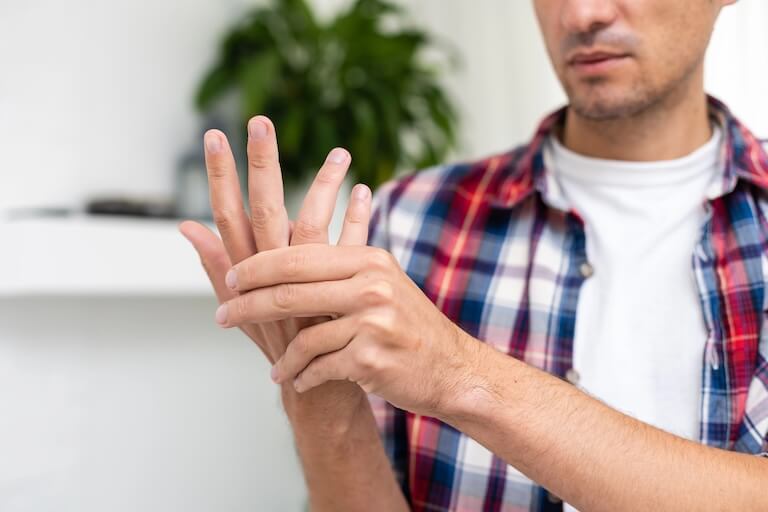If you’ve ever felt tingling, burning, or numbness in your hands or feet that just won’t go away, you’re not alone. These strange and sometimes painful sensations could be signs of peripheral neuropathy—a condition that affects millions of people and often makes even simple tasks, like walking or holding a cup, feel difficult.
Peripheral neuropathy can stem from many sources—diabetes, chemotherapy, chronic inflammation, or even an old injury—but the common thread is nerve damage. And while most treatments focus on managing symptoms, what if there were ways to support the body’s ability to heal those damaged nerves?
That’s where hyperbaric oxygen therapy, or HBOT, comes into the picture.
At Hyperbaric Wellness Center in Grand Rapids, we take a functional medicine approach—looking at how different systems of the body work together and supporting the body’s natural healing processes. One of the therapies we use, hyperbaric oxygen therapy, is showing promising results in helping people with nerve damage feel better—not just temporarily, but in deeper, more lasting ways.
In this blog, we’ll explore what peripheral neuropathy is, how HBOT works, what the research says, and how therapies like biofeedback therapy and personalized care can make a meaningful difference. Whether you’re currently living with nerve pain or just beginning to explore natural healing options, understanding how your body heals from the inside out is a powerful first step.
What Is Peripheral Neuropathy?
Peripheral neuropathy is a condition that occurs when the nerves outside your brain and spinal cord—called peripheral nerves—are damaged. These nerves help you feel sensations like temperature, touch, and pain, and they also support muscle movement. When they’re not working properly, the messages between your brain and body can get disrupted.
Common Symptoms
People with peripheral neuropathy might experience:
- Tingling or “pins and needles”
- Burning or sharp pain
- Numbness, especially in the hands or feet
- Muscle weakness or trouble with coordination
- Sensitivity to touch
These symptoms may start off mild but often worsen over time, interfering with everyday activities like walking, cooking, or even sleeping.
Common Causes of Peripheral Neuropathy
- Diabetes – High blood sugar can damage nerves over time.
- Chemotherapy – Some cancer treatments can harm healthy nerves as a side effect.
- Chronic inflammation – Autoimmune conditions or long-term infections may affect nerve health.
- Injury or surgery – Physical trauma or nerve compression (e.g., carpal tunnel) can play a role.
- Toxins or nutrient deficiencies – Exposure to certain chemicals or a lack of key nutrients, like B vitamins, can contribute.
Sometimes, no clear cause is found, which can make the condition even more frustrating for patients.
Why Traditional Treatments Aren’t Always Enough
For many people, medications are an important part of managing peripheral neuropathy. Drugs like pain relievers, anti-seizure medications, or certain antidepressants can help reduce nerve-related pain. For some, this brings real relief—and that matters.
But for others, medications may not fully address the pain, or they might come with side effects. And since these treatments mainly focus on managing symptoms, they often don’t help the nerves heal or regenerate.
That’s where functional medicine offers another layer of support. Rather than replacing traditional care, it asks deeper questions about root causes—and explores therapies that can support the body’s natural healing processes.
It’s not about choosing one approach over the other. It’s about exploring all available tools to help you feel your best—and understanding how therapies like hyperbaric oxygen and biofeedback might fit into that bigger picture.
How Does Hyperbaric Oxygen Therapy (HBOT) Work?
Hyperbaric oxygen therapy is a treatment where you sit or lie in a pressurized chamber and breathe in pure oxygen. The air pressure is increased to 1.5 to 3 times higher than normal, allowing your body to absorb much more oxygen than it can at normal pressure.
What Happens During HBOT?
Normally, oxygen is carried by red blood cells. During HBOT, the extra pressure allows oxygen to dissolve directly into your plasma, increasing oxygen delivery to areas with poor circulation or damaged tissue—including injured nerves.
This extra oxygen can:
- Reduce inflammation, a major cause of nerve pain
- Stimulate new blood vessel growth and improve circulation
- Support nerve repair and regeneration
- Boost the body’s natural healing processes at the cellular level
Why Oxygen Matters for Nerve Healing
Damaged nerves are often oxygen-starved. Whether due to high blood sugar, inflammation, or toxins, many nerves can’t get what they need to recover. But increasing oxygen in the right way has been shown to support nerve healing, not just temporary relief.
Research has shown that hyperbaric oxygen therapy:
- Promotes nerve regrowth and remyelination (the rebuilding of protective nerve coverings)
- Helps reduce chronic pain and restore motor function after nerve injury
- May calm overactive pain signals that are common in peripheral neuropathy
Let’s explore what the latest studies are saying.
The Research: Can Oxygen Really Heal Nerves?
While the idea of using oxygen to heal nerves may seem simple, the research behind HBOT is anything but. Here’s what recent studies are showing:
Nerve Regeneration and Pain Reduction
A 2025 study found that hyperbaric oxygen therapy supported nerve regrowth and remyelination, helping to restore healthy nerve function. Another study showed that HBOT helped improve motor function and reduced nerve-related pain after injury. The treatment appeared to calm overactive nerve signals, which often play a big role in the burning, tingling, or shooting pains people feel with neuropathy.
Chemotherapy-Induced Neuropathy
For those dealing with CIPN, or chemotherapy-induced peripheral neuropathy, HBOT is showing encouraging results. Studies found that it helped reduce nerve sensitivity and inflammation caused by chemotherapy drugs by calming immune overactivity.
Diabetic Peripheral Neuropathy
A 2024 review of randomized trials found that HBOT provided measurable benefits for people with diabetic neuropathy, including reductions in pain and improvements in nerve function.
While not a cure-all, these findings suggest that oxygen, when used therapeutically, can support the body’s ability to repair damaged nerves—especially when combined with a personalized care plan.
Biofeedback Therapy and Nerve Health
While oxygen works on a physical level to heal nerves, biofeedback therapy supports the nervous system’s regulation from the inside out.
Biofeedback therapy uses gentle sensors placed on your skin—typically on the fingers, forehead, shoulders, or chest—to monitor signals like heart rate, breathing, muscle tension, and skin temperature. With this real-time feedback, you work with a provider to learn how to relax your body and regulate your stress responses.
How This Supports Neuropathy
Nerve damage doesn’t just affect the body—it also affects how the brain interprets pain and stress. When the body is constantly in “fight or flight” mode, it creates a loop of tension, inflammation, and pain. Over time, biofeedback helps break that cycle.
In a typical session:
- You sit comfortably in a quiet room, often in a reclining chair.
- Sensors are gently attached to your skin.
- A monitor shows your stress responses in real time.
- You’re guided through techniques like deep breathing or visualization to calm your system.
This therapy can:
- Calm overactive nerve signals
- Reduce stress that worsens pain
- Improve circulation
- Retrain the brain’s response to chronic pain
When used with therapies like hyperbaric oxygen, biofeedback becomes part of a whole-body healing strategy that supports long-term regulation—not just symptom relief.
How Functional Medicine Looks at Neuropathy Differently
Unlike symptom-only approaches, functional medicine digs deeper to understand the why behind nerve dysfunction.
It asks:
- Is chronic inflammation affecting the nerves?
- Is blood sugar out of balance?
- Could nutrient deficiencies or toxins be contributing?
- Is the nervous system stuck in a stress loop?
This approach may involve advanced lab testing, health history analysis, and a personalized plan that could include:
- Hyperbaric oxygen therapy
- Biofeedback
- Anti-inflammatory nutrition
- Targeted supplements
- Detox support (if needed)
- Stress-reduction techniques
- Lifestyle changes that promote nerve repair
At Hyperbaric Wellness Center, we believe that healing happens when care is personalized—and when you have the right tools and support to restore balance in your body.
Moving Toward Healing, One Step at a Time
Peripheral neuropathy can feel overwhelming. But you’re not alone—and you’re not without options.
Functional medicine takes a deeper look at your health, combining advanced therapies with root-cause thinking to offer a more complete approach to nerve healing. With the right care, your body may have more healing potential than you think.
Here at Hyperbaric Wellness Center, we are committed to helping you explore natural, research-backed therapies that support your body’s ability to heal. Whether you’re just starting your journey or looking for new options, we’re here to help you find a path forward that fits your unique needs. Contact us today to start your journey toward health and wellness.
Resources
Awad-Igbaria, Y., Shapira, R., Hadanny, A., Polakiewicz, J., Kfyn, O., & Efrati, S. (2023). HBO treatment enhances motor function and modulates pain pathways following peripheral nerve injury. Journal of Translational Medicine, 21, 631. https://doi.org/10.1186/s12967-023-04414-x
Chou, P.-R., Wang, S.-H., Lu, I.-C., Hsieh, M.-C., Tai, M.-H., & Wu, S.-H. (2021). Simultaneous hyperbaric oxygen therapy during systemic chemotherapy reverses CIPN by inhibiting TLR4 and TRPV1 activation. Supportive Care in Cancer, 29, 6509–6523. https://doi.org/10.1007/s00520-021-06269-8
Kedar, D. J., et al. (2025). Long-term hyperbaric oxygen enhances nerve regeneration and remyelination in a sciatic nerve graft model. [Open-access preclinical report]. https://www.ncbi.nlm.nih.gov/pmc/articles/PMC12398382/
Wang, S.-H., Huang, S.-H., Hsieh, M.-C., Lu, I.-C., Chou, P.-R., Tai, M.-H., & Wu, S.-H. (2023). Hyperbaric oxygen therapy alleviates paclitaxel-induced peripheral neuropathy via TLR4/MyD88/NF-κB pathway suppression. International Journal of Molecular Sciences, 24(6), 5379. https://doi.org/10.3390/ijms24065379
Weng, J., Wang, J., Yin, Y., & Chen, H. (2024). Efficacy and safety of hyperbaric oxygen therapy for diabetic peripheral neuropathy: A systematic review and meta-analysis of randomized trials. Medicine (Baltimore), 103(23), e39774. https://pubmed.ncbi.nlm.nih.gov/39252242/

